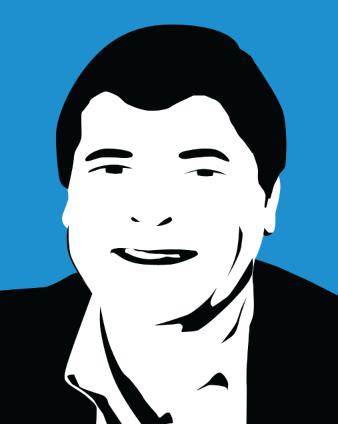Partner:
 Thank you to SAP for underwriting CXOTALK.
Thank you to SAP for underwriting CXOTALK.
Earlier this year, I discussed my first epiphany of 2015 at the annual IDC Directions Event in Boston: the evolution of the 3rd Platform and technologies such as cloud, social, mobile, and Big Data. What brought on such as moment? For me, it was one of IDC’s 6 technology accelerators: 3D printing.
From my experience of dot-matrix models in the early 1980s to several generations of HP LaserJet printers, all-in-one devices; and increasingly sophisticated printing, scanning, and document management solutions, printing has mainly meant generating a hard copy of an electronic document. And this has proven to be a traditional definition of “printing” that has stood the test of time. However, thanks to the rise of 3D printing, it appears that our understanding of this term will soon be disrupted.

Source: IDC 2015
Living in a brave new world where “printing” is not just “printing”
Online marketplaces – for example, eBay – and Internet storefronts such as Amazon certainly have been disruptive in a good way. They have all enabled disintermediation between customers and products, changing the state of retail and commerce forever.
During the early days of the Internet, I had the great fortune of being on an e-commerce panel with Jeff Bezos and Meg Whitman when they led Amazon and eBay, respectively. What we called early e-commerce during that event has truly become the “new normal.” Very rarely does a day go by when I don’t use either Amazon, eBay, or PayPal to make personal purchases and make business transactions.
More recently, I noticed a new trend emerging when I bought a new scale model for my train collection: the combination of an always-on marketplace and on-demand 3D printing of products. In the past, production of plastic models entailed building a model of the prototype, developing a mold, and then casting the model in a production run. This required significant lead time, production costs, and a lot size for production. If there were too few orders, the product would likely never be made. And if the model was an odd prototype with a limited market, you would be out of luck, too.
But for those of us not willing to take no for an answer, we had two alternatives:
- Scratch-building your own model, which is very time-intensive and clearly not for everyone.
- Purchasing brass models built overseas with small production runs and accompanied by an extremely high price tag.
Then I saw something really cool on eBay – an oddball N=1 model of a one-of-a-kind Amtrak executive car based on the Amfleet passenger fleet. What was more interesting was the description of how this model is made. No molds. No casting. Just a 3D printing process that generates a resin plastic model from a CAD drawing. Plus, it is shipped the same day it is printed. Wow! What a great example of 3D printing for a not-so-large mainstream market.
But that can’t be all that 3D printing can do. What else could this technology support? Anything we can imagine.
3D printing: Building a bridge between what’s available and what we want
Most of us have seen a new addition at some of our favorite restaurants, called Coca-Cola Freestyle. This dispenser offers 100+ different choices of soda. Literally at your fingertips, there is every Coca-Cola brand, options for caffeine/no caffeine, and different flavors of the same brand – just imagine, you can have a Coke Zero “classic” infused with lime and caffeine!
So after I played around with my selections and received my beverage of choice during a shopping trip in town, I decided to quell my curiosity of the inner workings of this marvel. Luckily, the manager obliged my request to open the machine, get an up-close look, and take some pictures.
According to the manager, the machine itself costs approximately US$8,000, representing a relatively high fixed cost expense. Coca-Cola Freestyle uses a series of cartridges, one for each soda brand and flavor. To maintain the machine, the cartridges are lower-priced, not that far from the price point of a higher-end LaserJet cartridge. The consumer selects the brand and options from an LDC display, with the available options of diet or regular, caffeinated or decaffeinated, and a flavor that may be different from the base brand.
In a fashion that would make my Yale economics professor proud, I performed a thumbnail calculation of the permutations and verified over 100 possible combinations. Cool!
No longer are individual brands stocked, but their components and the cartridges are. All the while, the machine simplifies the process of delivering exactly what the customer wants. But most important, a product of a great SAP customer who truly sees the future of the 3rd Platform as a competitive advantage.
However, I view this new innovation as 3D printing at work. Instead of printing the “recipe” from a book of choices, Coca-Cola Freestyle custom mixes ingredients in real time and produces a product on demand. In fact, this is just the start, in my opinion. Fast-food vendors now have the technology for customized French fries that could be printed on demand and cooked for the customer. And forget choosing from 31 flavors of ice cream – what about 31,000? You name it, and just imagine the possibilities!
Big Data, analytics, and 3D printing: A win-win for customers and businesses
In a world increasingly run by the Internet of Things, a soda machine produces data on consumption, transaction-level brand market share, and event-level ordering points for the cartridges in an automated real-time supply chain process. And then it hits me – that’s exactly the world SAP is supporting with technology innovations such as SAP S/4HANA. One full of digital transformation, simplification, and promise for better things.
Want more on how technology is creating an increasingly customized consumer marketplace? See The 5 Most Important Tools of the Make for Me Future.
Presented By: SAP
Sep 04, 2015
